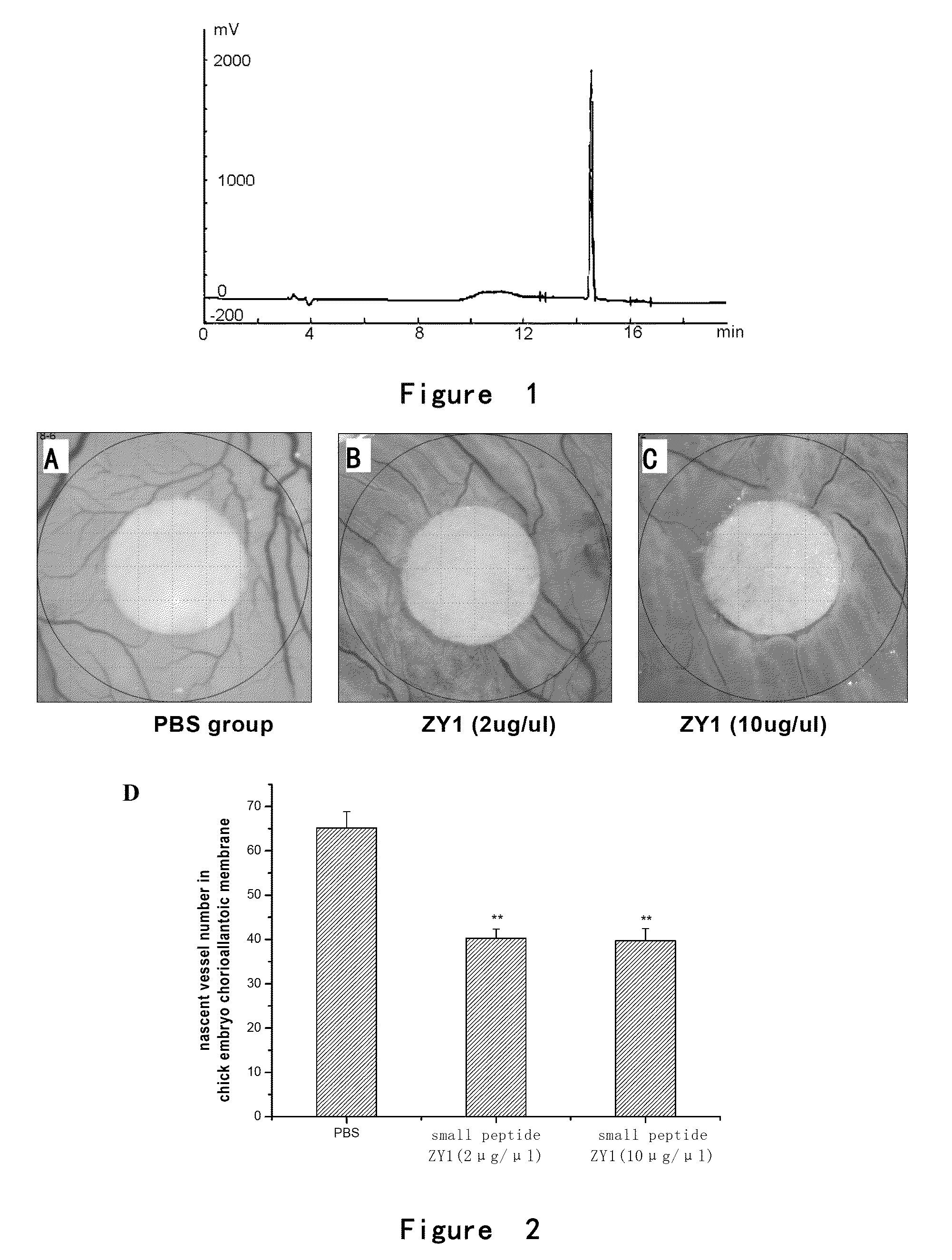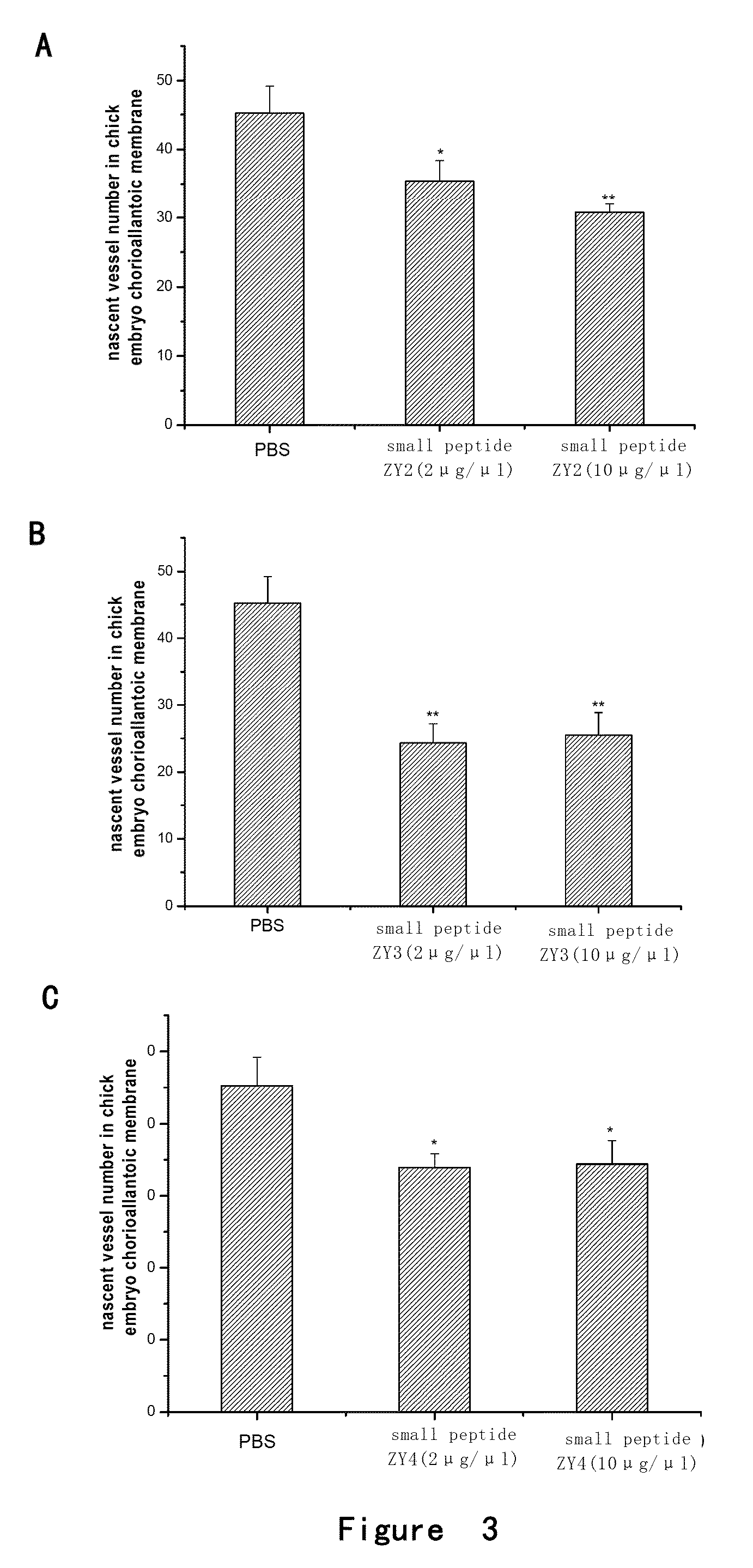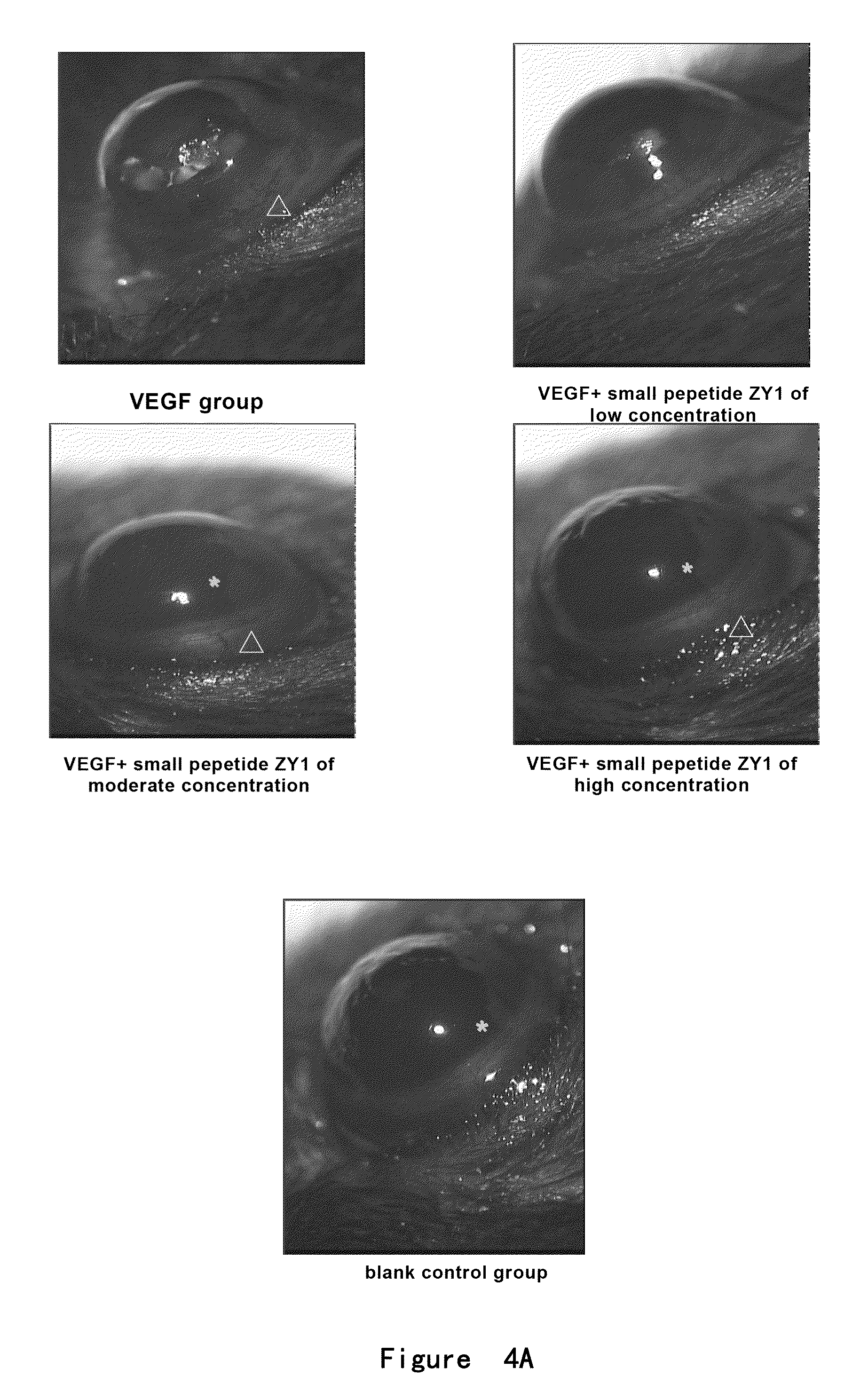Angiogenesis-inhibiting peptide and application thereof
a technology of angiogenesis and polypeptides, applied in the field of biopharmaceuticals, can solve the problems of many anatomical and functional barriers in eyes, unsatisfactory long-term efficacy, and easy destruction of local tissues, and achieve the effects of inhibiting angiogenesis, inhibiting the proliferation of endothelial cells, and inhibiting the migration of endothelial cells
- Summary
- Abstract
- Description
- Claims
- Application Information
AI Technical Summary
Benefits of technology
Problems solved by technology
Method used
Image
Examples
example 1
Synthesis of Polypeptide
[0115]The four ZY polypeptides represented by SEQ ID NO: 1-4 were synthesized by using the commercially available SYMPHONY polypeptide synthesizer.
[0116]
(SEQ ID NO: 1)ZY1: CVSLLRCTGCC GDENLHCVPV(SEQ ID NO: 2)ZY2: VSLLRCTGCCGDENLHCVPV;(SEQ ID NO: 3)ZY3: CVSLLRCTGCCGDENLHC;(SEQ ID NO: 4)ZY4: CASLLRCTGCCGDENLHCAPA
[0117]The steps were as follows: SYMIPHONY 12-channel peptide synthesizer (U.S. Protein Technologies. LLC.) was used and the reagents were calculated according to its software (Version. 201) and prepared. 2-Chlorotrityl Chloride Resin (Nankai Synthetic Technology Co., Ltd, Tianjin, China) was added into the reaction tubes and DMF (15 ml / g) (Dikma) was added and oscillation was carried out for 30 min. Solvents were suction filtered out through the sintered filter. 3-fold excess mole of Fmoc-L-Val-OH (small peptide ZY1), Fmoc-L-Val-OH (small peptide ZY2), Fmoc-L-Cys-OH (small the peptide ZY3) or Fmoc-L-Ala-OH (small peptide ZY4) amino acids (Suzhou Tianma...
example 2
Identification and Storage of Small Peptides ZY1-4
[0118]A small amount of individual small peptides ZY1-4 was taken and a purity identification with HPLC analysis and a molecular weight identification with ESI-MS were conducted.
[0119]The results showed that:
[0120]the elution peak of ZY1 was at 14.532 minutes with the purity of 98.85% (FIG. 1);
[0121]the elution peak of ZY2 was at 7.944 minutes with the purity of 98.01%;
[0122]the elution peak of ZY3 was at 6.646 minutes with the purity of 98.63%;
[0123]the elution peak of ZY4 was at 10.045 minutes with the purity of 97.31%.
[0124]Small peptides ZY1 totally had 21 amino acids and 5 of which were Cys. MW: 2221.66;
[0125]Small peptides ZY2 totally had 20 amino acids and 4 of which were Cys. MW: 2118.52;
[0126]Small peptides ZY3 totally had 18 amino acids and 5 of which were Cys. MW: 1926.28;
[0127]Small peptides ZY4 totally had 21 amino acids and 5 of which were Cys. MW: 2137.50;
[0128]The small peptides in white powder form were sealed, packa...
example 3
Inhibition Effect of Small Peptides ZY1-4 on Angiogenesis in Chick Embryo Chorioallantoic Membrane
[0129]Model of chick embryo chorioallantoic membrane was used and the methods were as follows:
[0130]The chick fertile eggs of 1-2 days (purchased from 36 Lianhuaqing Chicken Farm of Shanghai Xinghuo Farm) were put into a thermhygrostat (T=37° C., Humidity H=60-70%) to incubate for 5 days after sterilization. The eggs were overturned every morning and night. Onto the filter paper containing cortisone acetate (5 μg / μl, 5 μl / tablet), PBS (5 μl / tablet), low (2 μg / μl) or high (10 μg / μl) concentration of small peptides ZY1, ZY2, ZY3 or ZY4 (5 μl / tablet) were dropped respectively. After air-dried, the filter paper was placed between the major vessels on chorioallantoic membrane of fertile eggs and the eggs were sealed. The eggs were continuously placed in the thermhygrostat (T=37° C., Humidity H=60-70%) to incubate for 2 days without overturning. Then the chorioallantoic membrane was thoroughl...
PUM
| Property | Measurement | Unit |
|---|---|---|
| concentration | aaaaa | aaaaa |
| concentration | aaaaa | aaaaa |
| concentration | aaaaa | aaaaa |
Abstract
Description
Claims
Application Information
 Login to View More
Login to View More - R&D
- Intellectual Property
- Life Sciences
- Materials
- Tech Scout
- Unparalleled Data Quality
- Higher Quality Content
- 60% Fewer Hallucinations
Browse by: Latest US Patents, China's latest patents, Technical Efficacy Thesaurus, Application Domain, Technology Topic, Popular Technical Reports.
© 2025 PatSnap. All rights reserved.Legal|Privacy policy|Modern Slavery Act Transparency Statement|Sitemap|About US| Contact US: help@patsnap.com



